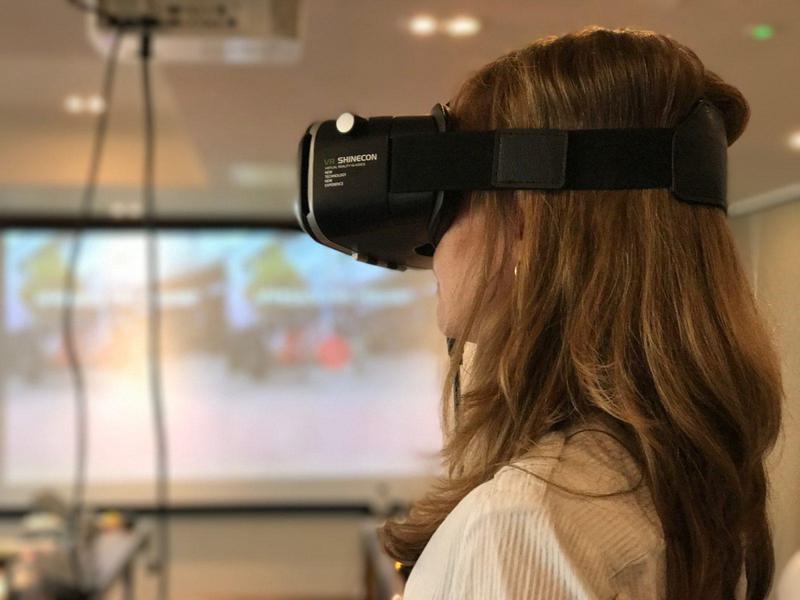Virtual reality (VR) offers new and unique opportunities to create more effective learning experiences.
The rate of change of learning technology is increasing. How do you know which new technology is going to offer a real advantage for your learners and which are going to disappear when the novelty factor wears off?
Virtual reality is no longer a gimmick
In their most recent hype cycle analysis, Gartner plot virtual reality as climbing the slope of enlightenment. The trough of disillusionment has been traversed and VR is steadily making its way to the plateau of productivity.
Plateau of Productivity: Mainstream adoption starts to take off. Criteria for assessing provider viability are more clearly defined. The technology's broad market applicability and relevance are clearly paying off.
There are certainly challenges to overcome and although the technology is available to consumers, the high end devices remain too expensive for mass adoption. Despite the limitations, the potential of VR for teaching new skills is becoming clear and client cases support this.
Real world VR training
Immersive learning environments used to be reserved for well funded government departments and big multi national corporations with highly skilled high-risk roles. If you were in the military or flew international airliners you’d be trained using the closest thing to real life as possible.
One of the original use cases for immersive training is for airline pilots. Various types of flight simulator are still used today by airlines to allow pilots to experience normal flights as well as simulated emergencies.
As technology advances we’re seeing the same type of immersive environments being created with relatively inexpensive headsets powered by off the shelf computers. Today you can train as a crane operator without stepping foot on a construction site. Prospective forklift truck drivers can sit in a replica truck and run through practice drills without any danger to colleagues or property.
It’s clear that as costs fall it becomes more and more immersive training opportunities will become viable. Smart L&D professionals are looking at VR to add value to their learning strategy.
VR training at NASA
NASA has been using virtual reality of some kind for over 25 years. In that time technology has not just caught up, it’s overtaken what any one agency can produce. From secret in-house technology to off the shelf headsets and collaborations with games companies and graphics cards manufacturers:
- 1991 - Flight helmet virtual research - developed to help prepare for repairs to the Hubble space telescope
- 1994 - N-Vision datavisor (CRT displays - 1280x1024)
- 2005 - N-Vision datavisor (Micro-OLED displays - 800x600)
- 2012 - In-house built (LCD displays - 1280x720)
- 2015 - Virtual reality training suit NDX-1 & Oculus Rift headset
- 2016 - HTC Vive headset and motion controllers + Manus VR glove, using Nvidia models for moon landing simulation
- 2017 - Unreal Engine 4 integrated with ARGOS micro gravity simulator
NASA, one of the earliest innovators in VR is now collaborating with games developers who use free, off the shelf game engine software to generate a photo realistic model of the International Space Station.
The early adopters of consumer virtual reality are already using it to increase employee and staff engagement. Home improvement retailer Lowe’s have been experimenting with virtual and augmented reality in their stores for a few years.
Holoroom how-to is a pilot programme that uses virtual reality to teach people skills like tiling a bathroom.
“Lowe’s will learn how innovations like Holoroom How To will enable instantaneous learning moments and massively scalable training opportunities that empower both customers and employees around the world.” - Lowe's Companies, Inc
They report that customers who went through the virtual reality training had 36% better recall of the skills than customers who watched a YouTube video featuring the same content.
How can virtual reality help you?
Learning professionals have a good track record of making new technology work. It’s sensible to be cautious when a much hyped technology promises to revolutionise learning, but there are some easy wins for the right scenarios.
Situational learning is the low hanging fruit for virtual reality. Put your learners into a situation that they will be experiencing in the future and let them practice before the event.
Your training scenario might not be as extreme as outer space, but any time it would be beneficial to immerse a learner in a situation before they experience it is a golden opportunity for VR.
Challenges to delivering VR training
The important thing is to know your limitations. There is likely to be some kind of immersive content that will fit your budget, and work with the hardware and networks that your learners use. Work with a supplier who will go into detail about your requirements, including the business needs that inform your learning outcomes as well as the technical side too.
With any new technology it’s a good idea to start out small and go for a test group of real learners to see how the project performs. A successful prototype can help pave the way for a full roll-out and highlight areas which can be improved or made more efficient for the full scale run.
We’re committed to providing innovative, engaging learning and part of that is making sure it works financially and technologically for you. The immersive experiences we’ve created scale from a handful of head mounted devices to thousands of desktop computers and are all built on sound learning design.
If you want to explore the possibilities of 360 video, VR or AR for your learning we’d love to hear from you.
